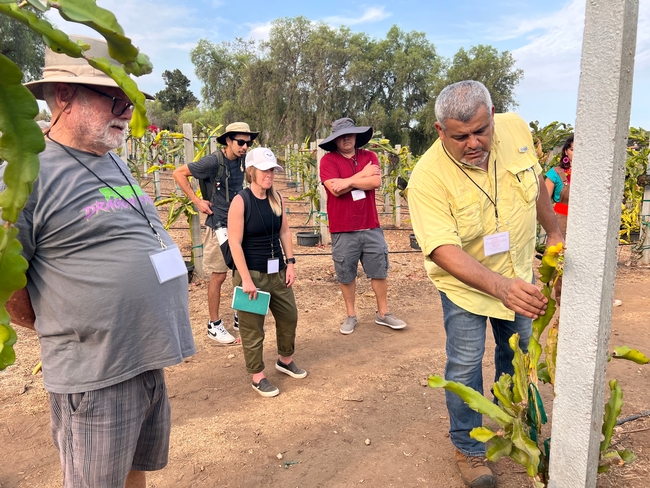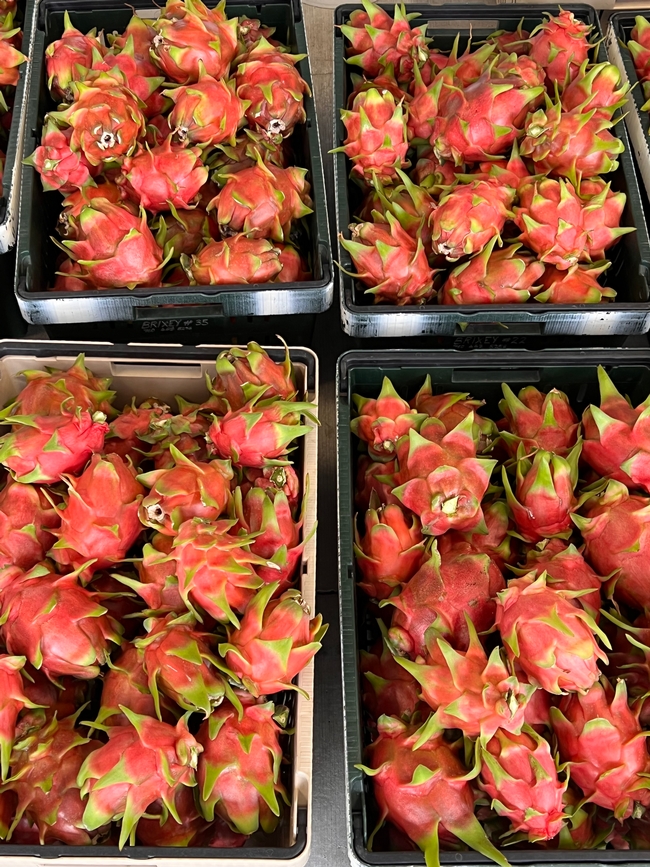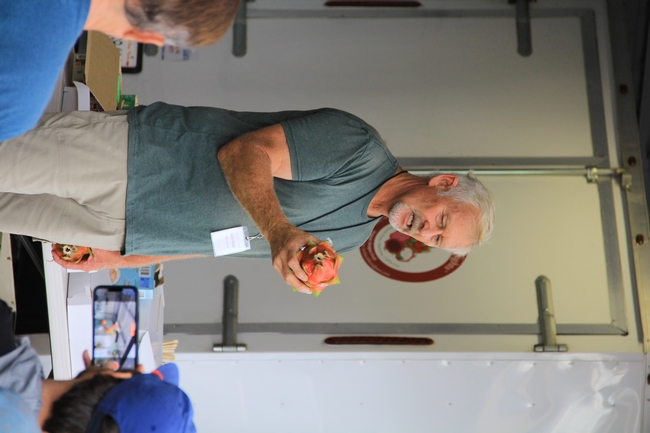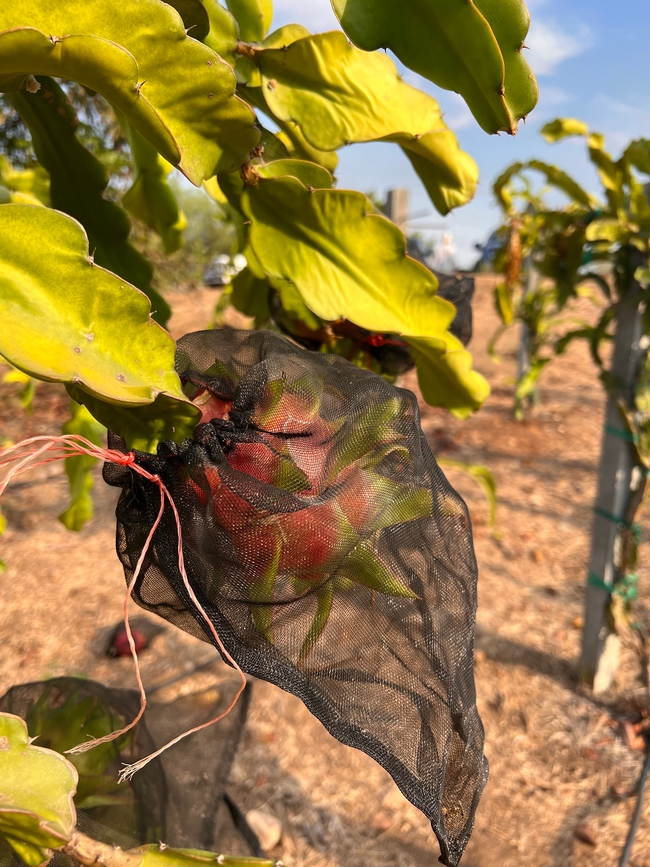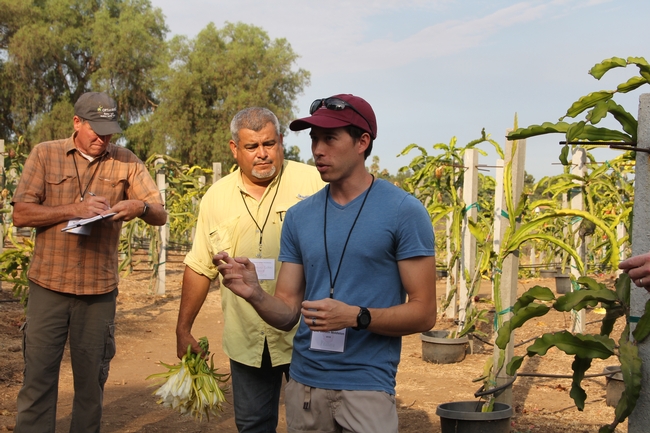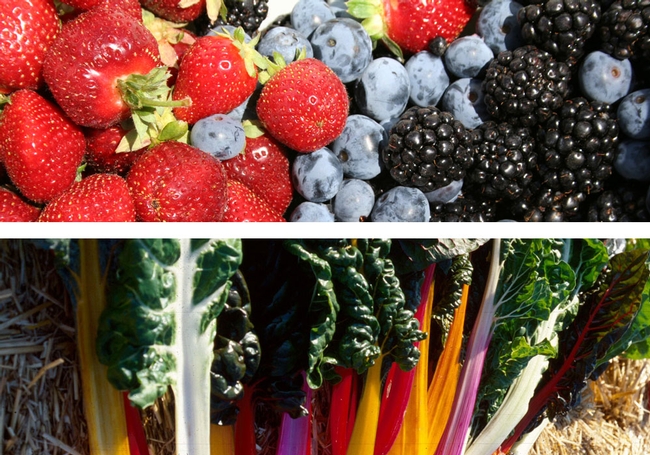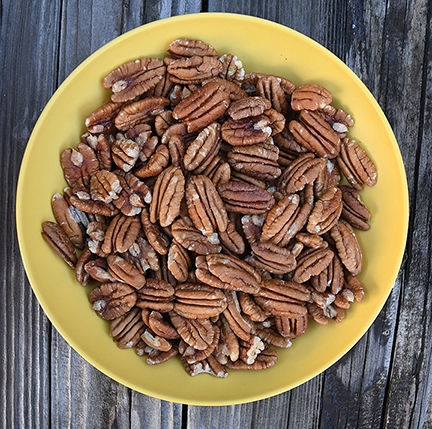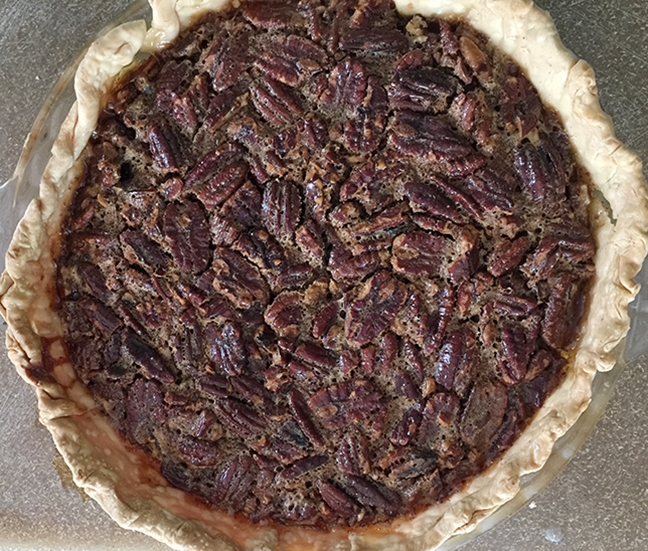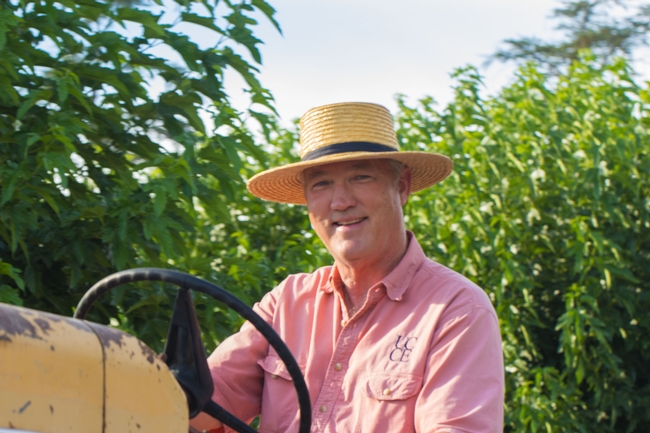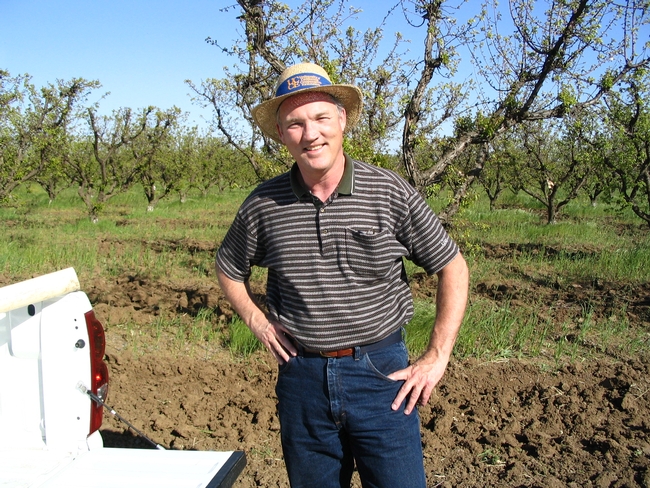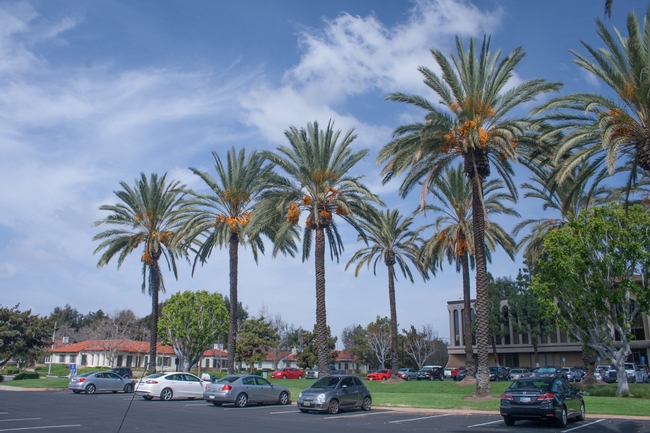Posts Tagged: fruit
Pitahaya/dragon fruit growers gather to learn from UCCE research and each other
Once you know what a dragon fruit looks like, you will never forget it. The bright red, sometimes yellow or purple, scaly skin makes for a dramatic appearance. One that will surely leave an impression. The flesh ranges from white to a deep pink and the flavor is often described as having hints of kiwi, watermelon, or pear.
Since 2007, the Pitahaya/Dragon Fruit Production Tour, has united dragon fruit growers of all levels and backgrounds. After a two-year hiatus due to the pandemic, registration for the 2022 tour filled up in less than 24 hours.
A group of 60 participants gathered Sept. 8 at the Wallace Ranch Dragon Fruit Farm in Bonsall to learn the latest research on growing the drought-tolerant specialty crop. Ramiro Lobo, a small farms and agricultural economics advisor for UC Cooperative Extension in San Diego County, introduced dragon fruit growers and other UC scientists.
“I can't remember a year where this event was not sold out. So, the need and demand is there,” said Eyal Givon, a long-time participant and dragon fruit grower.
The tour not only demonstrates how to grow the fruit, but it also grants participants access to plant material for varieties that are unavailable elsewhere.
“We have given out about 50,000 cuttings through our festival and some varieties were unique to us because we introduced them to the U.S.,” said Lobo.
During their time at Wallace Ranch, participants heard from the farm's owner, Neva Day, regarding the growing practices that have shaped her success today. Day has been growing organic dragon fruit since 2013 and has well over 5,000 plants on the ground and more than 20 varieties.
Eric Middleton, UCCE integrated pest management area advisor for San Diego County, talked about managing insects and pests that growers are likely to encounter such as Argentine ants.
According to Middleton, Pecan Sandies are a balanced source of fat, protein, and sugar, making them excellent bait for the sugar-loving insects.
Participants eventually made their way to Dragon Delights Farm located in Ramona. Kevin Brixey, the farm's owner, has been growing organic dragon fruit for six years.
Although Brixey was hosting this year's tour participants, he used to be one of them.
“I attended the Pitahaya Festival in 2014 and that's where I realized dragon fruit was something I could grow. There was a lot of good information being shared and a connection to other growers, so it was a major steppingstone for me,” he says.
Unlike traditional dragon fruit growers, Brixey uses shade to grow his dragon fruit after learning about the method from another grower.
“I was impressed. I liked how the fruit performed under shade and now I use it as a management tool,” Brixey explained. In Inland Valleys, shade can shield fruit from intense sunlight and protect them from unwanted guests that eat the fruit, such as birds.
At the Farm Bureau of San Diego County offices, participants learned about the history of dragon fruit growing in California, food safety, pest management, best production practices and much more.
The presenters included experts like Paul Erickson from Rare Dragon Fruit, Lobo, Middleton, Johanna del Castillo from UC Davis Department of Plant Pathology and Ariana Reyes, a community education specialist from UCCE San Diego.
When reflecting on his time participating in the production tour, Givon, who has been growing dragon fruit for about 20 years and manages a 20-acre farm in Moorpark, said he enjoys reconnecting with other growers the most.
“What others are doing, might be better than what I'm doing,” Givon said. “Or what I'm doing, could be better than what someone else is doing. This time together is good for us to learn from each other.”
Lobo agreed with Givon and added, “I hope that these tours become self-sustained, and that we go back to a research field day at Southcoast REC with regional tours in San Diego and Ventura as we did before, or any other counties.”
The Pitahaya/Dragon Fruit Production Tour is an annual event hosted by UCCE San Diego. To learn more about UCCE San Diego events, visit https://cesandiego.ucanr.edu.
USDA's nutrition advice doesn't align with spending
According to the USDA's dietary recommendations - which are represented in the MyPlate infographic - half the food Americans eat should be fruit and vegetables. However, the same agency allocates under one-half of 1 percent of agency funds to specialty crops like fruits and vegetables, reported Helene Bottemiller Evich in Politico.
For the story, Evich spoke to Glenda Humiston, vice president of UC Agriculture and Natural Resources (UC ANR), the research and outreach arm of the University of California. UC ANR extends science-based agricultural production and nutrition information to California farmers and communities. Humiston said California agricultural industry leaders have made it clear that they don't want traditional subsidies, like price supports.
"They want help with the infrastructure to do their jobs better," she said, including more funding for research labs and data collection that can help industry solve problems.
It isn't clear whether subsidies would reduce the cost of fruits and vegetables, nor does the potential of lower-cost healthy food ensure that people will eat it, the article said.
Many consumers also lack the time or the skills to prepare and cook their perishables. And some don't care for the flavor of healthful produce like kale, kohlrabi and rapini, to name a few.
The top fruits and vegetables consumed by Americans are potatoes (french fries) and tomatoes (primarily driven by ketchup). Only 14 percent of Americans consume 1.5 to 2 fruits and veggies per day, according to State of the Plate, a 2015 study on Americas' consumption of fruit and vegetables. (See below.) The USDA's dietary guidelines recommend 9 to 13 servings of fruit and veggies per day.
State of the Plate, a 2015 Study on America's Consumption of Fruit and Vegetables by the Produce for Better Health Foundation.
Pecan pie: A holiday tradition and a treat
“Ahh, nuts!”
This time of year, you're probably thinking “Ahh, pecans!”
And particularly, “Ahh, pecan pie!”
We do love our pecans. The U.S. produces 80 to 95 percent of the world's pecans, and most are grown in Georgia, according to the UC Davis Fruit and Nut Research and Information Center (FNRIC). In 2014, the U.S. produced 133,165 tons of pecans (in-shell) valued at more than $400 million. Of that, California contributed 2,500 tons, valued at a little more than $10 million, or less than 2 percent.
“Although pecan trees have existed in California for more than a century, the first commercial orchard in California was established in the mid-1970s in the Clovis area," FNRIC relates on its website. “Since then, pecan production has spread throughout the Central Valley, but it is not nearly as widely cultivated as other nut crops (almond, pistachio and walnut) in California." The nuts thrive on long, hot summers for proper maturation.
The pecan (Carya illinoinensis), native to Mexico and the southcentral and southeastern regions of the United States, is a member of the Juglandaceae family, which includes hickory and walnut. "Remains of pecans were found in archaeological excavations in Texas with human artifacts dating back to 6100 B.C.," according to the Nutcracker Museum. "The pecan, which is native only to North America, was found in or near river beds, and was a staple in the diets of both the natives and the early settlers."
“What's great about pecans is that they are delicious!” says Amy Block Joy, emeritus UC Cooperative Extension specialist, who, true to her name, finds "joy" in pecans. “They are one of my favorite nuts.”
“Pecans are an excellent source of vitamin E and other antioxidants, fiber, some B-vitamins and are also good sources of potassium, copper, iron, manganese and zinc,” says Joy, who holds a doctorate in nutritional sciences from UC Berkeley. “They are a rich source of oleic acid, a mono-saturated fatty acid. Pecans do not contain any cholesterol.”
And nuts are good for you, she said, noting that a study published recently in the journal BMC Medicine reported that having a daily amount (at least 20 grams) of nuts "cut people's risk of coronary heart disease by nearly 30 percent, their risk of cancer by 15 percent, and their risk of premature death by 22 percent.”
Meanwhile, all over the country — especially the South — pecan pie is synonymous with the holidays. It's an iconic Southern cuisine, a 19th century invention, that probably originated in the 1800s. Harper's Bazaar published the first known pecan pie recipe in 1886. Today, cooks clamor to make it their own — adding everything from bourbon to rum to chocolate to orange zest.
My late mother, born and reared on a Texas ranch where pecan trees flourished, treasured the pecan pie. She always pronounced it “Peh-CAHN” (never PEE-can) and prefaced it with "rich." Not “rich,” as in wealthy, but rich as in “don't-eat-too-much-of-this-or-you-will-engage-in-a-hate-relationship-with-your-scales.” If you're thin and have to "stand up twice to make a shadow," as the Southern saying goes, then no worries!
Did you know that pecan pie is the state dessert of both Texas and Oklahoma? And that the pecan is the "state nut" of Alabama and Arkansas? In Tennessee, it's known as the "state health nut." That's because it is!
In the Garvey household, our favorite pecan pie recipe is loaded with nuts — two cups. That's 66 pecans per cup or a total of 132 pecans, says nutritionist Amy Block Joy, who knows how to put the "nuts" in nutrition. We know how to put the pie in the pantry, and then to the holiday table.
Garvey's Unforgettable Southern Delight Pecan Pie
Makes 9-inch pie
3 eggs, large
1 tablespoon cornstarch
1 cup dark corn syrup, Karo
3/4 cup loosely packed brown sugar (don't press down)
1 tablespoon of white sugar
1 to 2 tablespoons of good quality dark rum (we used Myer's original dark Jamaican rum)
1/4 cup butter, melted
1 teaspoon pure vanilla extract
2 cups toasted pecans, halves only
One 9-inch unbaked pie crust (recipe below)
Preheat oven to 350 degrees. Spread pecans on baking sheet and toast at 350 degrees for 6 to 10 minutes. Set aside. In medium bowl, beat eggs with a fork or wire whisk. Add cornstarch and mix until blended.
Add corn syrup, sugar, rum, butter and vanilla. Stir in toasted pecans. Pour mixture into pie crust. Cover outer crust with loosely placed, crimped aluminum foil to prevent excess browning.
Bake at 350 degrees for about 50 minutes. At 40 minutes, remove aluminum foil from outer crust and cook for another 10 minutes, or until knife inserted in center comes out clean. The center should be slightly firm to the touch but a bit jiggly.
Place pie on wire rack and let cool at room temperature for two hours before serving.
Crust for 9-inch pie:
1-1/4 cups all-purpose flour
1-1/2 teaspoons granulated sugar
1/2 teaspoon salt
1 stick or ½ cup of cold unsalted butter, cut into chunks
1/4 cup ice water, plus an additional tablespoon if needed
In a medium bowl, combine flour, salt and sugar. Cut butter into flour mixture until it resembles coarse crumbs. Gradually sprinkle the water over the dry mixture, stirring until dough comes together enough to form a ball. Wrap dough in plastic wrap and refrigerate for at least one hour. Roll the dough out into a 12- to 13-inch circle. Place in pie plate and let it overhang 1/2-inch. Crimp the crust.
Maxwell Norton, director of UCCE in Merced County, to retire after 36 years
Maxwell Norton, UC Cooperative Extension director and advisor in Merced and Mariposa counties, plans to retire on July 1. Norton, who specializes in tree fruit, grapes and farmland preservation, has served Merced County growers for UC Agriculture and Natural Resources for 36 years.
Norton is “probably the kind of person everyone would like to know – a kind and gentle soul who exudes knowledge and wisdom,” said Bill Martin, executive director of Central Valley Farmland Trust.
For the past 10 years, Martin has worked on conserving farmland with Norton, who was a founding member of the Merced County Farmland and Open Space Trust, which merged with two other land trusts to become Central Valley Farmland Trust.
“He has an understanding of the landscape that is greatly appreciated,” Martin said of Norton. “He's very low-key, observant and provides timely input on provocative issues that come up at board meetings.”
Raised on a farm near Salida, north of Modesto, Norton studied pomology at Fresno State University, earning a B.S. and an M.S. in plant science before joining UC Cooperative Extension.
During his career, the UC Cooperative Extension advisor has helped Merced County growers solve problems in kiwifruit, Asian pears, prunes, peaches, strawberries, figs and pomegranates.
“When I started in 1979, there was rapid growth of two new industries – kiwifruit and Asian pears,” Norton said. “I conducted some early research trials on kiwifruit and authored a chapter of the new UC Cooperative Extension production manual for kiwifruit. I also spent a lot of time diagnosing Asian pear problems.”
Early in Norton's career, UC scientists introduced a device for measuring soil moisture called a neutron probe. The young advisor tested the device in peach orchards on clay-loam soils, attempting to correlate the probe, gypsum blocks, tensiometers and pressure chamber data.
“All of these tools were relatively new then,” said Norton. “Mid-day values had not been established yet so data collection entailed going out at 3 a.m. to pick leaves and measure the leaf water potential while crouching in the back seat of my government-issued Plymouth Fury.”
Collaborating with his UC Cooperative Extension colleague Roger Duncan in Stanislaus County, Norton conducted several research projects aimed at reducing labor costs in peaches. Projects included mechanical fruit thinning, chemical blossom thinning and various types of mechanical blossom thinning.
Research by Norton and his fellow Cooperative Extension advisors showed that mature prune trees could be pruned every other year and still produce desirable fruit size and maintain yields. Growers widely adopted the practice of alternate year pruning. Later, Cooperative Extension set out to demonstrate the new integrated prune farming practices where IPM tools were integral parts of the system.
In the early 1980s, when many grape growers were spraying pesticides three to four times a year, leafhoppers developed resistance to some insecticides. Norton and other UC experts saw the potential for biological control by the Anagris parasitic wasp. UC Cooperative Extension advisors persuaded growers to not spray the first or second generations of leafhoppers and let the beneficial insects control the pests. Now grape growers rarely have to spray for leafhoppers.
Over Norton's career, agriculture in Merced County has diversified. He began having strawberry meetings translated into Hmong or Lao for immigrant growers and studying pomegranates and figs.
Off the farm, Norton has been active in community development, organizing workshops for farmers on how to export their products, chairing the Merced County Economic Development Task Force twice and serving twice as president of the county's Chamber of Commerce.
“My favorite part of the job has always been doing farm calls, where I went out and visited growers and diagnosed problems, explaining the nature of the problem, and most importantly, suggest things to try,” Norton said.
In retirement, Norton plans on playing his tenor and bari sax in jazz bands, training UC Master Gardeners and volunteering with the local historical society and other organizations.
He has also been granted emeritus status by UC Agriculture and Natural Resources.
RELATED ARTICLE
Capital Press: Advisor helps SJ Valley growers meet challenges, opportunities
Ornamental landscape date palm: An overlooked urban fruit tree
One fruit, though, is not on the radar of foodies and foragers. Yet it's crunchy, sweet, flavorful, often seedless, and very common in Southern California landscapes. It's the fruit of the date palm, rarely thought of as a food source in our urban environment, more frequently viewed as a nuisance because dates fall off trees, where they create litter that must be cleaned up.
Unfortunately, coastal Southern California lacks the high sustained heat and aridity for proper fruit maturation and curing to produce traditional soft-ripe dates of good eating quality. The dates that fall from the trees have been unattractive to gather for sale and consumption, processes that could help to resolve the fruit litter problem in the landscape.
However, some varieties of dates can be eaten at a less than a mature state, traditionally called “khalal.” Fruit in the khalal stage have attained their maximum size, are typically yellow or red, have a sweet flavor, and are crunchy, somewhat like an apple. Several date varieties, like ‘Barhee,' are sometimes sold and eaten in the khalal stage. Fortunately, from a food standpoint (or unfortunately if you are a landscape manager), date fruits do mature to the khalal stage in coastal Southern California because high sustained heat and aridity are not required to attain this stage of development.
While ‘Barhee' is not too common as a landscape subject, another variety, ‘Zahidi,' is common and typically produces abundant fruits in coastal Southern California. These golden yellow fruits are conspicuous and showy in the khalal stage, are typically on the palm for several months from late fall to spring, and are really good to eat. Also, in many cases, these fruits are seedless! (Note to horticulture geeks: date palms are dioecious - separate male and female trees - and because nearly all edible date palms in the landscape are female, their flowers were pollinated by other species of landscape Phoenix. The resulting hybrid fruits are seedless, or pollination is not required for fruit to set and develop - parthenocarpy.)
Urban foragers looking for their next food adventure, or even a potential enterprise, might want to consider taking advantage of this otherwise nuisance and unwanted fruit. Khalal fruit can be gathered from the ground and cleaned. But it is best to collect them off the palm. Cutting an inflorescence (entire fruit stalk) and lowering it carefully to the ground would be ideal.

Khalal-stage fruits of the date variety ‘Zahidi’ are really good to eat: crunchy, sweet, and flavorful. Also, they are seedless (D. R. Hodel).

